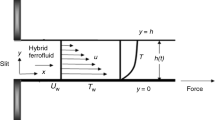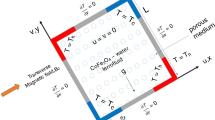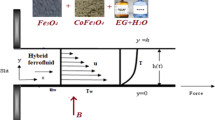Abstract
Nanotechnology plays a pivotal role in introducing innovative strategies for medical treatment, such as hyperthermia cancer through the utilization of ferrite nanoparticles, such as magnetite (Fe3O4) and cobalt ferrite (CoFe3O4). The stability of nanoparticles ensures their effective delivery and therapeutic activity. This study is dedicated to exploring the behavior of the hybrid ferrofluid, Fe3O4/CoFe2O4, in a biopolymer solution composed of ethylene glycol and water that flows over an inclined stretching sheet with a magnetic dipole effect. The primary focus of this investigation lies on examining the influence of suction and slip velocity. The formulated governing partial differential equations are initially transformed into simplified ordinary differential equations using appropriate similarity variables. The numerical solutions are then computed by employing the Keller box method. The obtained results demonstrate that the slip parameter diminishes the velocity profile while enhancing the temperature profile. However, the suction effect retards the movement of the nanoparticle and also decays the heat storage in the hybrid ferrofluid. The slip parameter has reduced the shear stress by 49.86% % and the heat transfer rate by 28.56%, respectively. The suction effect significantly enhances both physical quantities. The ferrite nanoparticles with the magnetic dipole, in terms of the ferrohydrodynamics effect, decline the velocity profile but enhance the temperature profile. These findings are essential in integrating the use of ferrite hybrid nanoparticles in cancer treatment.






Similar content being viewed by others
Data Availability
No datasets were generated or analysed during the current study.
Abbreviations
- U w :
-
Stretching velocity
- T w :
-
Sheet temperature
- T ∞ :
-
Ambient or bulk temperature
- T c :
-
Curie temperature
- (u, υ):
-
Velocity components for (x, y)
- ρ :
-
Density
- μ :
-
Dynamic viscosity
- ρC p :
-
Heat capacity
- k :
-
Thermal conductivity
- T :
-
Temperature
- M :
-
Magnetization
- H :
-
Magnetic field
- g :
-
Gravitational acceleration
- β ∗ :
-
Thermal expansion
- α ∗ :
-
Inclination angle
- d :
-
Distance of the magnetic dipole
- K :
-
Thermomagnetic
- Pr :
-
Prandtl number
- ε :
-
Curie temperature
- χ :
-
Viscous dissipation
- δ :
-
Partial slip
- S :
-
Suction
- β :
-
Ferrohydrodynamic interaction parameter
- α :
-
Dimensionless distance
- λ :
-
Mixed convection
- Gr x :
-
Grashof number
- Re x :
-
Reynold number
- C f :
-
Local skin friction
- Nu x :
-
Nusselt number
- τ w :
-
Wall shear stress
- q w :
-
Heat transfer rate
References
Choi, S. U. S., & Eastman, J. A. (1995). Enhancing thermal conductivity of fluids with nanoparticles. Argonne National Lab.(ANL).
Fernandes, D. A. (2023). Theranostic polymeric nanoparticles for cancer. BioNanoScience, 13(4), 1609–1644.
Sahar, E., Abo-NeimaEmad, M., & Elsehly. (2022). Cancer treatment by laser and electrochemical therapy combined with magnetic nanoparticles as potent therapy against Ehrlich ascites carcinoma. BioNanoScience, 12(3), 851–866.
Rasool, G., Shafiq, A., Khan, I., Baleanu, D., Nisar, K. S., & Shahzadi, G. (2020). Entropy generation and consequences of MHD in Darcy–Forchheimer nanofluid flow bounded by non-linearly stretching surface. Symmetry, 12(4), 652.
Shuguang Li, A., Abbasi, W. F., Gul, M., Ijaz Khan, M., Nafasova, G., & Hejazi, H. A. (2024). Heat and mass transfer characteristics of Al2O3/H2O and (Al2O3+ Ag)/H2O nanofluids adjacent to a solid sphere: A theoretical study. Numerical Heat Transfer, Part A: Applications, 85, 1–19.
Li, S., Maria Imtiaz, M., Ijaz Khan, R., Kumar, N., & Akramova, K. S. (2024). Applications of Soret and Dufour effects for Maxwell nanomaterial by convectively heated surface. Numerical Heat Transfer, Part A: Applications, 85, 1–15.
Moradiya, M. A., Ladani, A., Ladani, J., Raiyani, C., & Markna, J. H. (2019). New way to treat cancer: magnetic nanoparticle based hyperthermia. Journal of Chemical Science and Engineering, 2(1), 58À60.
Darwish, M. S. A., Nguyen, N. H. A., Ševců, A., Stibor, I., & Smoukov, S. K. (2016). Dual-modality self-heating and antibacterial polymer-coated nanoparticles for magnetic hyperthermia. Materials Science and Engineering: C, 63, 88–95.
Samakosh, S. F., Bahari, A., Hamidabadi, V. F., & Moghaddam, H. M. (2023). Preparation and characterization of core@ shell structures of Glycerin@ Fe3O4, and Al2O3@ Fe3O4 nanoparticles for use in hyperthermia therapy. BioNanoScience, 13, 2168–2179.
Zhu, H., Zhang, C., Liu, S., Tang, Y., & Yin, Y. (2006). Effects of nanoparticle clustering and alignment on thermal conductivities of Fe3O4 aqueous nanofluids. Applied Physics Letters, 89(2), 023123.
Papell, S. S. (1965). Low viscosity magnetic fluid obtained by the colloidal suspension of magnetic particles. US Patent 3,215,572.
Odenbach, S. (2004). Recent progress in magnetic fluid research. Journal of Physics: Condensed Matter, 16(32), R1135.
Rosensweig, R. E. (1985). Ferrohydrodynamics Cambridge Univ (p. 344). Press.
Zongxin, Y. (2023). Interfacial dynamics of ferrofluids in Hele-Shaw cells. Purdue University.
Abbas, K., Wang, X., Rasool, G., Sun, T., Yin, G., & Razzaq, I. (2023). Recent developments in the application of ferrofluids with an emphasis on thermal performance and energy harvesting. Journal of Magnetism and Magnetic Materials, 587, 171311.
Bidros, D. S., Liu, J. K., & Vogelbaum, M. A. (2010). Future of convection-enhanced delivery in the treatment of brain tumors. Future Oncology, 6(1), 117–125.
Struchtrup, H. (2014). Thermodynamics and energy conversion. Springer.
LS Rani TitusAnnamma Abraham. (2019). Flow of ferrofluid over an inclined stretching sheet in the presence of a magnetic dipole. In Transactions on Engineering Technologies: World Congress on Engineering 2018 (Vol. 26). Springer.
Seleznyova, K., Strugatsky, M., & Kliava, J. (2016). Modelling the magnetic dipole. European Journal of Physics, 37(2), 025203.
Khan, A., Gul, T., Zaheer, Z., & Amiri, I. S. (2019). The flow of ferromagnetic nanofluid over an extending surface under the effect of operative Prandtl model: A numerical study. Advances in Mechanical Engineering, 11(12), 1687814019896128.
Rashad, A. M., Hussein Togun, M. A., Mansour, T. S., & Armaghani, T. (2024). Unsteady MHD hybrid nanofluid mixed convection heat transfer in a wavy porous cavity with thermal radiation. Journal of Thermal Analysis and Calorimetry, 149, 1–18.
Zhang, R., Zaydan, M., Mansoor, A., Raju, C. S. K., Wakif, A., & Shah, N. A. (2024). Further insights into mixed convective boundary layer flows of internally heating jeffery nanofluids: Stefan’s blowing case study with convective heating and thermal radiation impressions. Case Studies in Thermal Engineering, 55, 104121.
Huminic, G., & Huminic, A. (2018). Hybrid nanofluids for heat transfer applications–A state-of-the-art review. International Journal of Heat and Mass Transfer, 125, 82–103.
Soomro, F. A., Usman, M., El-Sapa, S., Hamid, M., & Haq, R. U. (2022). Numerical study of heat transfer performance of MHD Al2O3-Cu/water hybrid nanofluid flow over inclined surface. Archive of Applied Mechanics, 92(9), 2757–2765.
Tiwari, R. K., & Das, M. K. (2007). Heat transfer augmentation in a two-sided lid-driven differentially heated square cavity utilizing nanofluids. International Journal of Heat and Mass Transfer, 50(9-10), 2002–2018.
Anuar, N. S., Bachok, N., & Pop, I. (2021). Influence of buoyancy force on Ag-MgO/water hybrid nanofluid flow in an inclined permeable stretching/shrinking sheet. International Communications in Heat and Mass Transfer, 123, 105236.
Anwar, T., Kumam, P., & Thounthong, P. (2021). Fractional modeling and exact solutions to analyze thermal performance of Fe3O4-MoS2-water hybrid nanofluid flow over an inclined surface with ramped heating and ramped boundary motion. IEEE Access, 9, 12389–12404.
Alabdulhadi, S., Waini, I., Ahmed, S. E., & Ishak, A. (2021). Hybrid nanofluid flow and heat transfer past an inclined surface. Mathematics, 9(24), 3176.
Hang, X. (2022). Mixed convective flow of a hybrid nanofluid between two parallel inclined plates under wall-slip condition. Applied Mathematics and Mechanics, 43(1), 113–126.
Ali, B., Khan, S. A., Hussein, A. K., Thumma, T., & Hussain, S. (2022). Hybrid nanofluids: Significance of gravity modulation, heat source/ sink, and magnetohydrodynamic on dynamics of micropolar fluid over an inclined surface via finite element simulation. Applied Mathematics and Computation, 419, 126878.
Ya MalkinS, A., & Patlazhan, A. (2018). Wall slip for complex liquids – Phenomenon and its causes. Advances in Colloid and Interface Science, 257, 42–57.
Choi, J., Kim, S. G., Im, J. P., Kim, J. S., Jung, H. C., & Song, I. S. (2011). Endoscopic prediction of tumor invasion depth in early gastric cancer. Gastrointestinal Endoscopy, 73(5), 917–927.
Claude Navier, Mémoire sur les lois du mouvement des fluides. 1822: éditeur inconnu, 389–440.
Andersson, H. I. (2002). Slip flow past a stretching surface. Acta Mechanica, 158(1-2), 121–125.
Wang, C. Y. (2002). Flow due to a stretching boundary with partial slip—An exact solution of the Navier–Stokes equations. Chemical Engineering Science, 57(17), 3745–3747.
Zeeshan, A., Majeed, A., Ellahi, R., & Zia, Q. M. Z. (2018). Mixed convection flow and heat transfer in ferromagnetic fluid over a stretching sheet with partial slip effects. Thermal Science, 22(6 Part A), 2515–2526.
Majeed, A., Zeeshan, A., Bhatti, M. M., & Ellahi, R. (2020). Heat transfer in magnetite (Fe 3 O 4) nanoparticles suspended in conventional fluids: Refrigerant-134A (C 2 H 2 F 4), kerosene (C 10 H 22), and water (H 2 O) under the impact of dipole. Heat Transfer Research, 51(3), 217–232.
Iqbal, Z., Ahmad, B., & Maraj, E. N. (2019). A numerical study of ferrofluid (fe 3 o 4) in the presence of a magnetic dipole inspired by slip and viscous dissipation effects submerged in a porous medium. Journal of Porous Media, 22(1), 107–117.
Majeed, A., Zeeshan, A., & Hayat, T. (2019). Analysis of magnetic properties of nanoparticles due to applied magnetic dipole in aqueous medium with momentum slip condition. Neural Computing and Applications, 31, 189–197.
Sravan, T., & Kumar. (2021). Hybrid nanofluid slip flow and heat transfer over a stretching surface. Partial Differential Equations in Applied Mathematics, 4, 100070.
Kamis, N. I., Jiann, L. Y., Shafie, S., & Rawi, N. A. (2023). Comparative analysis of Fe3O4/CoFe2O4 and NiZnFe2O4/MnZnFe2O4 hybrid ferro-nanofluids flow under magnetic dipole effect over a slip stretching sheet. Case Studies in Thermal Engineering, 51, 103580.
Hayat, T., Qasim, M., & Mesloub, S. (2011). MHD flow and heat transfer over permeable stretching sheet with slip conditions. International Journal for Numerical Methods in Fluids, 66(8), 963–975.
Turkyilmazoglu, M. (2013). Heat and mass transfer of MHD second order slip flow. Computers & Fluids, 71, 426–434.
Gupta, P. S., & Gupta, A. S. (1977). Heat and mass transfer on a stretching sheet with suction or blowing. The Canadian Journal of Chemical Engineering, 55(6), 744–746.
Chaudhary, S., & Choudhary, M. K. (2018). Partial slip and thermal radiation effects on hydromagnetic flow over an exponentially stretching surface with suction or blowing. Thermal Science, 22(2), 797–808.
Ibrahim, W., & Shankar, B. (2013). MHD boundary layer flow and heat transfer of a nanofluid past a permeable stretching sheet with velocity, thermal and solutal slip boundary conditions. Computers & Fluids, 75, 1–10.
Maheswari, C., Ramana, R. M., Shaw, S. M., Dharmaiah, G., & Noeiaghdam, S. (2023). Numerical investigation on MHD forchheimer flow of Fe3O4−H2O, Cu−H2O and Ag−H2O nanofluids over permeable stretching sheet with radiation. Results in Engineering, 18, 101194.
Yazdi, M. H., Abdullah, S., Hashim, I., & Sopian, K. (2011). Slip MHD liquid flow and heat transfer over non-linear permeable stretching surface with chemical reaction. International Journal of Heat and Mass Transfer, 54(15-16), 3214–3225.
Idris, S., Jamaludin, A., Nazar, R., & Pop, I. (2023). Heat transfer characteristics of magnetized hybrid ferrofluid flow over a permeable moving surface with viscous dissipation effect. Heliyon, 9(5), e15907
Anantha Kumar, K., Sandeep, N., Sugunamma, V., & Animasaun, I. L. (2020). Effect of irregular heat source/sink on the radiative thin film flow of MHD hybrid ferrofluid. Journal of Thermal Analysis and Calorimetry, 139, 2145–2153.
Padervand, M., Vossoughi, M., Yousefi, H., Salari, H., & Gholami, M. R. (2014). An experimental and theoretical study on the structure and photoactivity of XFe 2 O 4 (X= Mn, Fe, Ni, Co, and Zn) structures. Russian Journal of Physical Chemistry A, 88, 2451–2461.
Dinarvand, M., Abolhasani, M., Hormozi, F., & Bahrami, Z. (2023). Experimental investigation and performance comparison of Fe3O4/water and CoFe2O4/ water ferrofluids in presence of a magnetic field in a cooling system. Journal of the Taiwan Institute of Chemical Engineers, 148, 104927.
Peter, A., ThompsonSandra, M., & Troian. (1997). A general boundary condition for liquid flow at solid surfaces. Nature, 389(6649), 360–362.
CebeciP, T. (1988). Bradshaw, Physical and computational aspects of convective heat transfer. Springer.
Chen, T. S., & Mucoglu, A. (1977). Analysis of mixed forced and free convection about a sphere. International Journal of Heat and Mass Transfer, 20(8), 867–875.
Kamis, N. I., Jiann, L. Y., Shafie, S., & Rawi, N. A. (2023). Numerical simulation of convection hybrid ferrofluid with magnetic dipole effect on an inclined stretching sheet. Alexandria Engineering Journal, 76, 19–33.
Brinkman, H. C. (1952). The viscosity of concentrated suspensions and solutions. The Journal of Chemical Physics, 20(4), 571–571.
Karniadakis, G. E., Beskok, A., & Gad-el-Hak, M. (2002). Micro flows: Fundamentals and simulation. Applied Mechanics Reviews, 55(4), B76–B76.
Lin, W. (2008). A slip model for rarefied gas flows at arbitrary Knudsen number. Applied Physics Letters, 93(25), 253103.
Kamis, N. I., Rawi, N. A., Jiann, L. Y., Shafie, S., & Ilias, M. R. (2023). Thermal characteristics of an unsteady hybrid nano-casson fluid passing through a stretching thin-film with mass transition. Journal of Advanced Research in Fluid Mechanics and Thermal Sciences, 104(2), 36–50.
Rasool, G., & Shafiq, A. (2023). Numerical exploration of the features of thermally enhanced chemically reactive radiative Powell–Eyring nanofluid flow via Darcy medium over non-linearly stretching surface affected by a transverse magnetic field and convective boundary conditions. Applied Nanoscience, 13(1), 229–246.
Shuguang Li, M., Khan, I., Khan, S. U., Abdullaev, S., Mohamed, M. M. I., & Amjad, M. S. (2023). Effectiveness of melting phenomenon in two phase dusty carbon nanotubes (Nanomaterials) flow of Eyring-Powell fluid: Heat transfer analysis. Chinese Journal of Physics, 86, 160–169.
Funding
This research was funded by a grant from Universiti Teknologi Malaysia through vote number numbers Q.J130000.3854.31J28 (UTMER).
Author information
Authors and Affiliations
Contributions
N.I.K, N.A.R and L.Y.J: Conception and design of study
N.I.K: Acquisition of data
N.I.K, N.A.R, L.Y.J and S.S: Analysis and/or interpretation of data
N.I.K, N.A.R, L.Y.J and S.S: Drafting the manuscript
N.I.K, N.A.R, L.Y.J and S.S: Revising the manuscript critically for important intellectual content.
Corresponding author
Ethics declarations
Ethical Approval
Given the theoretical nature of this study, it did not involve human or animal subjects. Consequently, no ethical approval was required.
Consent to Participate
Not applicable. As this study is theoretical in nature, it did not involve direct participation from human or animal subjects.
Consent for Publication
Not applicable. This theoretical study does not contain any individual person’s data in any form (including any individual details, images, or videos).
Research Involving Humans and Animals Statement
None.
Informed Consent
None.
Competing interests
The authors declare no competing interests.
Additional information
Publisher’s Note
Springer Nature remains neutral with regard to jurisdictional claims in published maps and institutional affiliations.
Rights and permissions
Springer Nature or its licensor (e.g. a society or other partner) holds exclusive rights to this article under a publishing agreement with the author(s) or other rightsholder(s); author self-archiving of the accepted manuscript version of this article is solely governed by the terms of such publishing agreement and applicable law.
About this article
Cite this article
Kamis, N.I., Jiann, L.Y., Rawi, N.A. et al. The Impacts of Suction and Partial Slip on Ferrohydrodynamics Hybrid Ferrofluid (Fe3O4/CoFe2O4) over an Inclined Stretching Sheet. BioNanoSci. (2024). https://doi.org/10.1007/s12668-024-01388-y
Accepted:
Published:
DOI: https://doi.org/10.1007/s12668-024-01388-y




